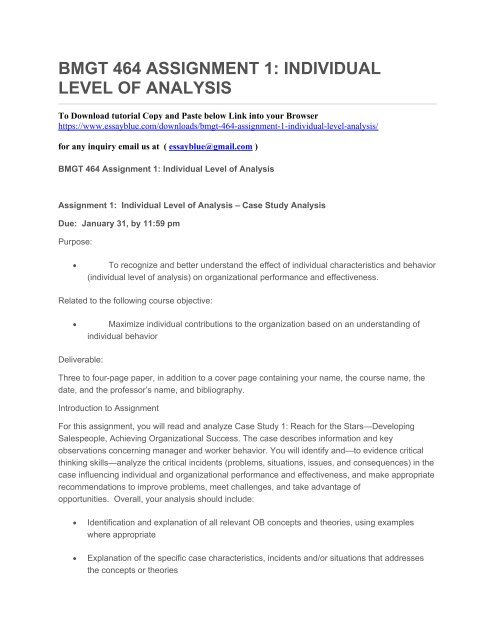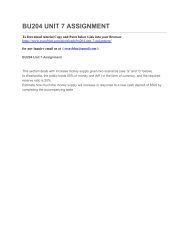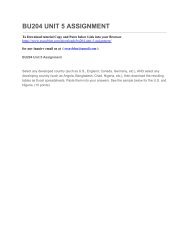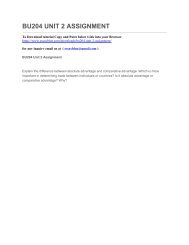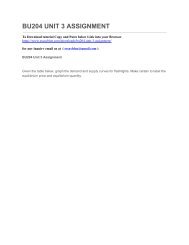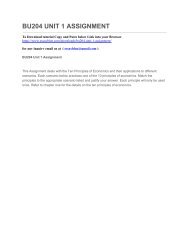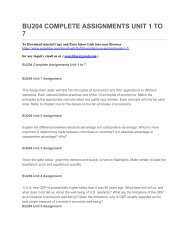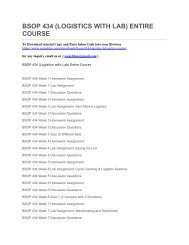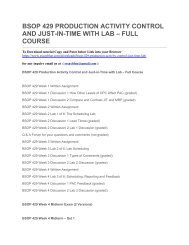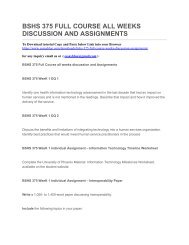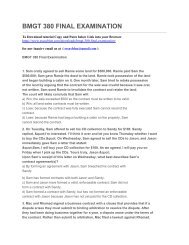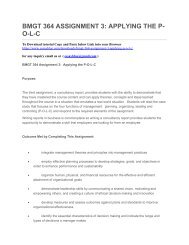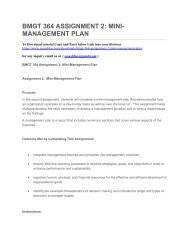BMGT 464 ASSIGNMENT 1 INDIVIDUAL LEVEL OF ANALYSIS
You also want an ePaper? Increase the reach of your titles
YUMPU automatically turns print PDFs into web optimized ePapers that Google loves.
<strong>BMGT</strong> <strong>464</strong> <strong>ASSIGNMENT</strong> 1: <strong>INDIVIDUAL</strong><br />
<strong>LEVEL</strong> <strong>OF</strong> <strong>ANALYSIS</strong><br />
To Download tutorial Copy and Paste below Link into your Browser<br />
https://www.essayblue.com/downloads/bmgt-<strong>464</strong>-assignment-1-individual-level-analysis/<br />
for any inquiry email us at ( essayblue@gmail.com )<br />
<strong>BMGT</strong> <strong>464</strong> Assignment 1: Individual Level of Analysis<br />
Assignment 1: Individual Level of Analysis – Case Study Analysis<br />
Due: January 31, by 11:59 pm<br />
Purpose:<br />
To recognize and better understand the effect of individual characteristics and behavior<br />
(individual level of analysis) on organizational performance and effectiveness.<br />
Related to the following course objective:<br />
Maximize individual contributions to the organization based on an understanding of<br />
individual behavior<br />
Deliverable:<br />
Three to four-page paper, in addition to a cover page containing your name, the course name, the<br />
date, and the professor’s name, and bibliography.<br />
Introduction to Assignment<br />
For this assignment, you will read and analyze Case Study 1: Reach for the Stars—Developing<br />
Salespeople, Achieving Organizational Success. The case describes information and key<br />
observations concerning manager and worker behavior. You will identify and—to evidence critical<br />
thinking skills—analyze the critical incidents (problems, situations, issues, and consequences) in the<br />
case influencing individual and organizational performance and effectiveness, and make appropriate<br />
recommendations to improve problems, meet challenges, and take advantage of<br />
opportunities. Overall, your analysis should include:<br />
<br />
<br />
Identification and explanation of all relevant OB concepts and theories, using examples<br />
where appropriate<br />
Explanation of the specific case characteristics, incidents and/or situations that addresses<br />
the concepts or theories
Analysis of the relevance of identifying and better understanding individual characteristics<br />
Analysis of pros and cons of key incidents or situations (i.e., what are the drawbacks and/or<br />
positives associated with the situation as it related to individual performance and/or<br />
organizational productivity and effectiveness?)<br />
Specific recommendations to address problems, challenges, and opportunities, and a<br />
proposed follow-up or evaluation<br />
Read and follow all the Instructions carefully. The paper must clearly demonstrate your ability to<br />
understand how and why individual characteristics and behavior influence organizational<br />
performance and effectiveness. Demonstrate critical thinking, as described under higher thinking<br />
levels in Bloom’s Taxonomy (find through Google). Strive to be original along with applying data,<br />
information, and ideas from the required reading and outside research. Use examples and research<br />
information to support claims. Use American Psychological Association (APA) format for in-text<br />
citations and the reference list. Use the comprehensive outline format described in Instruction 9 to<br />
present your research findings, analysis, recommendations, and significant personal learning.<br />
Instructions<br />
1) Review the assignment purpose, course objective, and introduction above and the<br />
Assignment Grading rubric.<br />
2) Read the case below, Reach for the Stars—Developing Salespeople, Achieving<br />
Organizational Success. This case was created for <strong>BMGT</strong> <strong>464</strong>-6380. Your analysis must evidence<br />
understanding of the case’s specific characters, context, and circumstances. Avoid generalizations<br />
that might apply to similar cases available on the Internet or in previous courses.<br />
3) Compose a brief abstract (no longer than a paragraph) synthesizing case highlights, putting<br />
the characters and incidents in context, and generally setting the scene for the detailed analysis to<br />
follow.<br />
4) Identify and analyze at least three critical incidents (problems, situations, issues, and<br />
consequences) in the case that influenced individual and organizational performance and<br />
effectiveness. Explain how and why you think the incidents influenced individual and organizational<br />
performance and effectiveness. Discuss the pros and cons of key incidents or situations (i.e., what<br />
are the drawbacks and/or positives associated with the situation as it related to individual<br />
performance and/or organizational productivity and effectiveness?)<br />
5) Make appropriate recommendations to address problems, meet challenges, and take<br />
advantage of opportunities, and propose follow-up or evaluation.<br />
6) Draw data, information, and ideas from at least six required resources (at least two from<br />
each of Weeks 1, 2, and 3) listed in the weekly Schedules, plus at least two credible, authoritative,<br />
relevant outside sources for a total of at least eight references.Your outside references should show<br />
a mix of scholarly and applied/practical sources, largely drawn from UMUC’s Information Library
System (ILS), and including classic writings. Review APA citation materials and Tips on Research<br />
Sources in Course Content. Cite research sources within the paper’s body using APA in-text<br />
formatting. Include a Reference list with complete source information at the end of the paper. See<br />
specific formatting and heading template instructions below in Instruction 9. Alphabetize references<br />
under each subheading. Please note my preference for including publication date within in-text<br />
citations. You are expected to paraphrase, using quotes only when the source’s verbatim statements<br />
uniquely enhance meaning and understanding. Deductions will be taken when quotes are overused<br />
and found to be unnecessary. See examples below:<br />
In-text citation:<br />
(Casey, 2002, p. 50). [Include publication date]<br />
Reference citation:<br />
Casey, C. (2002). Critical Analysis of Organizations: Theory, practice, revitalization. London: Sage.<br />
7) Identify and present in bold font at least six different OB concepts, theories, methods,<br />
strategies, or practices in your analysis. Demonstrate through context and/or endnotes your<br />
understanding of the terms’ definition and meaningfulness to the meet the assignment’s purpose and<br />
course objectives.<br />
8) Determine what significant learning and understanding you gained from your research and<br />
analysis. Identify and evaluate at least three valuable take-aways you learned from your<br />
organization change analysis, and how you envision specifically applying them to your job or career.<br />
9) Use the outline below for headings and subheadings. Your deliverable will use a<br />
comprehensive outline format with expository content under each heading to present your analysis,<br />
evaluation and recommendations in standard composition style. Feel free to add other headings,<br />
subheadings or make modifications as your findings, ideas, and assertions dictate. Use examples<br />
and cite support sources as presented above.<br />
1. Title page (your name, the course name, assignment, the name of the organization, the<br />
date, and instructor’s name)<br />
2. Case abstract<br />
3. Critical incidents (occurrence, fact, change, e.g., product diversification and market growth<br />
as reflected by “expanded its product line from aging-related to sports injury-related medical<br />
supplies and equipment” in the case study)<br />
Critical incident 1<br />
Critical incident 2<br />
Critical incident 3<br />
[and so forth]
1. Recommendations (e.g., offer workshops or individual coaching with personality tests to<br />
more effectively identify, validate, share, and utilize personality traits, preference strengths,<br />
job-fit methods, and interactionist perspectives—see Saylor/OBsection 3.1)<br />
2. Follow up (or evaluation—this is an area in which outside research and resources would be<br />
a plus; e.g., how will management determine if the intervention recommended above actually<br />
worked? Perhaps assessing personality trait-based problem behavior during performance<br />
refers could work, or including manager reports from the personality tests referred to, say,<br />
three and six months after the intervention would provide useful results…?)<br />
1. Significant learning (see Instruction 8 for details about take-aways)<br />
Learning or Take-away 1<br />
Learning or Take-away 2<br />
Learning or Take-away 3:<br />
and so forth<br />
1. References (required course materials and outside research sources)


